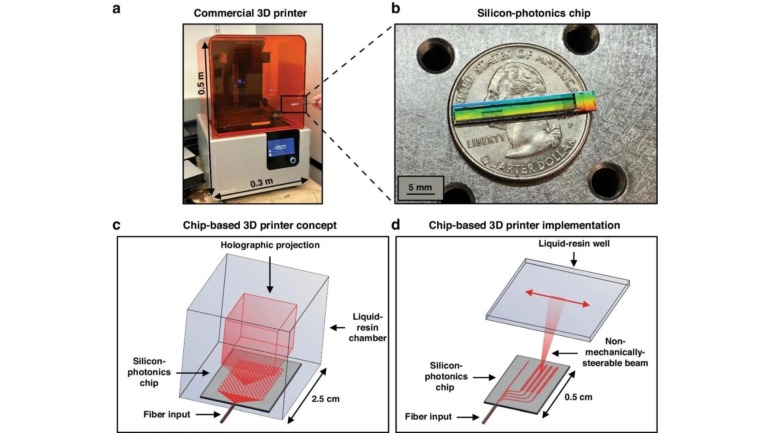MIT and UT Austin researchers have unveiled a groundbreaking palm-sized 3D printer powered by a coin-sized photonic chip. This compact device, smaller than a coin, could revolutionize rapid prototyping and personalized manufacturing on the go.
The key to this innovative 3D printer lies in its millimeter-scale photonic chip, which emits programmable light beams into a resin well. When the light touches the resin, it solidifies, forming a three-dimensional shape. This technology enables users to quickly and easily create inexpensive, personalized items while on the move, such as a fastener for a loose bicycle wheel or a crucial medical device component.
“This system redefines what a 3D printer is. It’s no longer a bulky box confined to a lab, but a handheld and portable device,” said Jelena Notaros, lead author and professor at MIT.
The MIT team, experts in silicon photonics, had previously developed integrated optical-phased-array systems that steer light beams using microscale antennas on a chip. By adjusting the optical signal’s speed or latency on each side of the antenna array, they could change the light beam’s direction.
Simultaneously, the UT Austin team had showcased specialty resins that could be rapidly cured using visible light wavelengths. This breakthrough in visible-light-curable resins, combined with the MIT team’s expertise in silicon photonics, paved the way for the chip-based 3D printer’s realization.
The prototype features a single photonic chip with 160-nanometer-thick optical antennas, fitting on a US quarter. Powered by an off-chip laser, these antennas emit a steerable visible light beam into the photocurable resin held in an indentation on a clear slide. Electrical signals steer the beam non-mechanically, solidifying the resin wherever it strikes.
To effectively modulate visible-wavelength light, the researchers integrated compact liquid crystal modulators onto the chip, which are highly efficient and only about 20 microns long.
The team successfully 3D printed any two-dimensional shape in seconds using their prototype. Their ultimate goal is to create a system that produces a visible light hologram, enabling volumetric 3D printing in a single step.
These portable 3D printers could find applications in various domains, such as enabling medical professionals to build custom parts for medical devices or helping engineers quickly prototype ideas on job sites.


